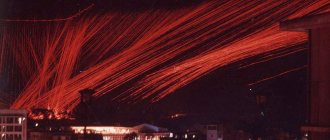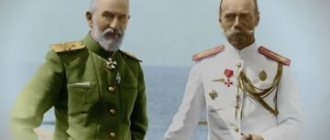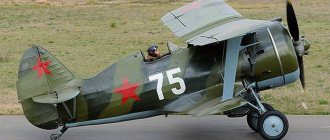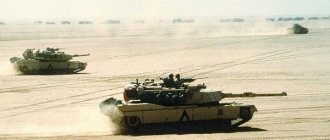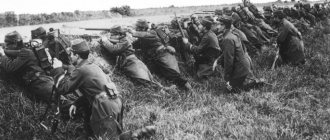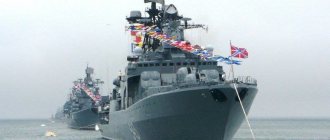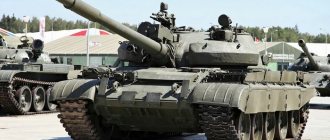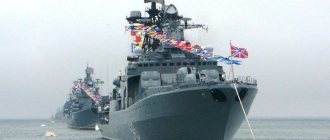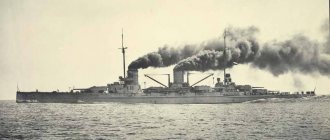MiG-15 - a surprise for the Americans
In June 1950, an armed conflict broke out on the Korean Peninsula. The DPRK's allies were the USSR and China, and the Republic of Korea was supported by a coalition of countries led by the United States. This confrontation became one of the hottest stages of the so-called Cold War between the Soviet Union and the United States, with the main battles taking place in the air.
Let us immediately note that overseas pilots waged a real war against the people of North Korea, using all types of weapons, including bombs with biological filling. Soviet aviation and anti-aircraft artillery units were mainly based in northeast China and participated only in the air defense of important targets in the DPRK and China. For example, the main task of the Soviet 64th Fighter Air Corps was air cover of bridges and the Suphung hydroelectric power station on the border river (between Korea and China) Yalu, as well as rear communications of Chinese and Korean troops.
© wikipedia.org The main task of the Soviet 64th Fighter Air Corps was air cover of bridges and the Suphun hydroelectric power station.
In particular, the regiments of the 324th Air Division, commanded by three times Hero of the Soviet Union, Colonel Ivan Kozhedub, were based at the Andong airfield. The 176th Guards and 196th Air Regiments were armed with the latest Soviet MiG-15 fighters with the insignia of the PRC and DPRK Air Forces, which fell into the circle of “interests” of the Americans.
In November 1950, US pilots, who had previously reigned supreme in the skies of Korea, for the first time met with arrow-shaped aircraft, which from a height of 10 thousand meters in a rapid dive successfully attacked American aircraft. Army General Douglas MacArthur was forced to report to the US Joint Chiefs of Staff: for the first time ever, our pilots encountered military equipment that was significantly superior to the American one, their morale was falling, and the flights did not bring the same effect, and the Sabers did not help either.
Let us clarify: the first air battle between swept-wing jet fighters (Soviet MiG-15) and American F-86 Saber took place on December 17, 1950. And on April 12, 1951, an event occurred in the skies of Korea that went down in US aviation history as “Black Thursday.” In less than 10 minutes, the US Air Force lost 14 aircraft: 10 heavy bombers and 4 fighters, another 15 heavy bombers were written off due to damage after returning to base. And about 120 US Air Force personnel were captured.
© nationalmuseum.af.mil
MiG-15 fighters attack a B-29 bomber. 1951
MiG and Saber: Capture and Study
65 years ago, on October 6, 1951, the Soviet pilot, regiment commander Evgeniy Pepelyaev managed to complete an extremely difficult and important mission. He was able to not only shoot down the latest US F-86A Saber fighter, but also did it so carefully that the plane remained practically intact and suitable for study. The United States managed to acquire the MiG-15 only after the end of the war. What were the twists and turns of this rivalry and what did it give to the opponents in the air war?
MiG Alley
Paradoxically, at the beginning of the Korean War of 1950–1953, no one expected the confrontation between the MiG-15 and the Sabers, which became one of the most striking symbols of the entire conflict. At first, South Korea was almost captured entirely by North Korean troops. Then the aircraft of the intervening UN forces (primarily, of course, the United States) relatively easily removed the few piston-powered North Korean Yaks, La and Ilys from the sky. The subsequent chain of events that were hardly predictable in advance led to the appearance of Soviet fighters in the skies of North Korea, which initially defended the airspace of the People's Republic of China from air raids by Chiang Kai-shek.
In the sight of the B-29. From the collection of Diego Zampini https://www.airspacemag.com/
The MiGs fighting in Korea since November 1, 1950, according to the US military authorities, managed to do what neither the Messerschmitts nor the Focke-Wulfs could do in World War II - to “land” US strategic aviation. Of course, an intense but relatively local conflict pursued completely different goals than a world war. But after a series of heavy losses, from November 8, 1951, B-29s stopped appearing over Korea during the day (including thanks to the development of night navigation systems). Despite their best efforts, the pilots of the F-80 Shooting Star and F-84 Thunderjet could not restore their recent unchallenged air supremacy. There was a catastrophic shortage of Sabers (deployed in December 1950) and naval Panthers. The area in which Soviet pilots operated over Korea was given the name “Migov Alley” by the Americans.
Ejection from a MiG. NARA
However, before the appearance of the Saber, in a month and a half of fighting, Soviet pilots lost three MiG-15s, and the same number in two weeks of fighting with the Sabers. It is not surprising that both pilots and designers of the USSR felt a burning desire to get to know their overseas “counterpart” better.
Catch the Saber
It was for this purpose that in April 1951, a special group of test pilots from the Air Force Research Institute (from 13 to 16 people) arrived in Manchuria, where Soviet units were based. Their task was to force the Saber to land at the airfield. However, despite a solid raid and even combat experience in the Great Patriotic War, nothing worked out for the group. First, in an air battle, with his own numerical superiority, Major Perevozchikov was shot down and killed, and two more aircraft were damaged. And then the group commander, Lieutenant Colonel Dzyubenko, crashed during landing. This is where the story of the special “hunt” ended.
And again the paradox that is so often encountered in war - after the failures of the “specialists”, they managed to get the desired trophy in a “regular” battle. This was done by one of the most outstanding fighters of the Korean War, Yevgeny Pepelyaev. He learned to fly on the I-16 and “fought” against the future Marshal Savitsky in a training battle. Then he taught pilots himself. He trained on the 2nd Belorussian Front, where he made 10 combat missions, but due to the calm he never met the enemy. But in 1945, Pepelyaev had the opportunity to fight against the Japanese in Manchuria on a Yak-9T, commanding the 300th Fighter Regiment. After the war, the pilot mastered the latest jet fighter La-15, and then the MiG-15. Moreover, Pepelyaev not only flew himself, but also trained pilots.
With the outbreak of the Korean War, Pepelyaev, by his own admission, literally seized the opportunity to repay his debt to his fallen friends and the state, which had trained him as a pilot for many years. At the same time, as the commander of the 196th air regiment, Pepelyaev set the task for his subordinates - “after the war, everyone will return home with victory.” Fortunately, young pilots, as a rule, did not receive experience in real air battles.
The moment of truth came on October 6, 1951. To the southwest of Pakchon, 10 MiG-15s under the command of Pepelyaev and 16 Sabers fought in battle. First, Pepelyaev fired at the wingman of the Saber pair, but then he himself came under a frontal attack from another pair. Pepelyaev depicted a right combat turn, and switched to a left one - he had been practicing this technique even before the war. Now the Soviet fighter, according to the pilot’s description, was behind, higher and slightly to the right of the Saber. Pepelyaev turned the car over so that the negative overload pinned him to the seat, placed the sight mark on the enemy’s canopy and fired. The 37-mm shell entered exactly behind the Saber’s cockpit. Therefore, Pepelyaev did not pursue the “opponent” - he was finished.
"Steal the Saber." Drawing by Dan Zoernig. oldgloryprints.com
The Saber, smoking and barely staying in the air, was noticed by Captain Sheberstov from the neighboring 176th regiment - and also fired. The victory was credited to him. The Saber was still able to reach the shore and land at low tide; the pilot in the rubber boat was picked up by a helicopter. Soviet aircraft, with the help of half a thousand Chinese, despite massive bombing of the entire area, pulled out the plane, loaded it onto Studebakers and delivered it to the regiment.
The pilots, of course, could not miss the opportunity to sit in the cockpit of their longtime enemy. Pepelyaev himself liked the spacious cockpit of the American fighter, the convenient attitude indicator and excellent visibility. Pepelyaev later wrote that the MiG was inferior to the Saber in horizontal maneuverability, range, critical speed and gliding. The advantages of Soviet fighters were strong armament, vertical maneuver and ceiling.
Upon arrival in Moscow, the trophy was “dissected” at the Air Force Research Institute named after. Chkalova. Unfortunately, it was impossible to fly a fighter with a dented nose, damaged power train and numerous holes. I had to limit myself to blowing in the TsAGI wind tunnel.
The Saber was larger and heavier than the MiG-15bis, but its engine had less thrust. It is not surprising that the F-86, according to the conclusions of TsAGI specialists, was significantly inferior to the MiG in vertical speed and rate of climb at all altitudes, and at low altitudes it was somewhat inferior in maximum speed. Thanks to the large brake flaps, the Saber decelerated faster than the MiG in horizontal flight. It’s worth clarifying right away that in real air battles everything could have turned out differently.
Due to the strictest secrecy, the number of specialists allowed to see the trophy was extremely limited, so it was not immediately possible to understand the purpose of some of the devices. Of particular interest was the AN/APG-30 radio rangefinder with a horn-shaped antenna coupled with an optical sight. This device quickly gave an accurate range to the target, and the resulting data was immediately entered into the optical sight. Two gyroscopes in the AIC sighting system made it possible to develop lead angles in azimuth and vertical (if there was only one gyroscope, as on the Soviet ASP-3, then longer tracking of the target with the aiming mark was required). The rangefinder range, according to tests at the Chkalov airfield, reached 2500 m or more. But the first tests were carried out on the ground, but in the air on the Li-2 NII-17, completely different numbers were obtained - first up to 800 m, and then, after reconfiguration, up to 4500 m! Moreover, the official manual for the F-86F gave... from 137 to 2700 m (450–9000 ft).
Another Saber was captured on May 5, 1952 - the plane of World War II veteran Lieutenant Colonel Walker "Bud" Makhurin was damaged by anti-aircraft fire and in July also migrated to the USSR. The pilot was captured. According to one legend, it was he who asked to see a Korean pilot who spoke Russian in battle.
Thanks to the tests, it was possible to develop measures to counter US radars. The ASP-4N "Snow" sight and the SRD-3 "Grad" radio range finder appeared in the USSR - analogues of captured ones. And a Soviet thermal imager was even tested in the skies of Korea.
"MiG" in the wrong hands
The war is over. On September 20, 1953, North Korean Air Force Lieutenant Kim Sum No (No Kum-Sok), taking off from Sunan Air Base near Pyongyang, flew on a MiG-15bis to Kimpo Air Base in South Korea. At the same time, he did not even suspect a reward of $100,000, which was promised during the battles to any pilot who himself presented his MiG to the “Free World”. Kim Sum No, according to his memoirs, began fighting in 1951, at the age of 19. During the flight to the US base, he was especially afraid that the MiG's visit would be considered an attack - and even if he was lucky enough to land, the pilot would be taken prisoner. During landing, he almost collided with a Saber flying peacefully on schedule.
MiG-15bis in the US Air Force, with markings painted over. wikimedia.org
The best pilots were called in to test the long-awaited “curiosity” that had literally fallen from the sky, including the living legend of world aviation, Chuck Eager.
During World War II, Eager tested the Airacobra, which he really liked - contrary to the opinion of most US pilots. The next plane was the P-47 Thunderbolt, on which Eager even survived an engine explosion. Then his squadron was sent to England to beat the Germans. On March 5, 1944, in a battle with three FV-190s, 21-year-old Iger was shot down over France. Fortunately, local residents helped the pilot get to the Maki partisans. Then the pilot’s path lay through the Pyrenees to neutral Spain, and Eager also carried the wounded navigator of the downed B-24. The Spanish police...immediately threw Higuera into prison. However, the pilot, who had survived much more severe trials, used a rescue kit to cut out the brass grille in the window and escaped. By May Iger was already in England.
In theory, the downed pilot was sent home - if captured again, he could hand over the underground fighters who had helped him before. But Iger was not the type to make only 8 sorties during the war. He reached General Eisenhower - and began to fight again, this time on a Mustang. Before the end of the war, Higer was credited with shooting down 11 German aircraft, 5 of them in just one sortie.
After the war, on October 27, 1947, Eager became the first person in the world to break the sound barrier in horizontal flight. It was believed that the MiG-15 could also be supersonic, so among other testers, it was Iger who was entrusted with testing the Soviet aircraft. Let's not forget that the pilots had to fly an airplane with an unfamiliar system of measures. In addition, the weather during testing was inclement. The second tester was Tom Collins. The tests lasted only 11 days.
Compared to the Saber, the MiG in the USA showed a higher ceiling and a better rate of climb. The trophy also accelerated better. But the MiG’s equipment “sweared” a lot, since it required constant attention from the pilot. The aircraft was also noted for its tendency to unexpectedly pitch up and spin. Iger's work was rated extremely highly. General Boyd even stated that “...thanks to Iger, we now know more about the MiG than the Russians.”
.
Since the MiGs, according to the US Air Force, could calmly choose the time and place for an attack from a height of about 15 km (the ceiling is up to 16 km), strike and immediately go up, as an antidote they came up with the tactics of “flow” (“jet”) stream"). 16 fighters were divided into fours, flying at five-minute intervals and at different altitudes - from 9 to 10 km. The vehicles traveled at high speed, so if one group was suddenly attacked, others could quickly come to its aid.
Eager himself noted that a pilot with extensive experience would “kick the enemy’s ass” in any machine—Sabre or MiG. It is curious that Pepelyaev adhered to exactly the same opinion.
Evgeny Pepelyaev and Chuck Eager. Photo from the Pepelyaev family archive. Filmed by the author
Many years later, two outstanding pilots of the 20th century - Evgeny Pepelyaev and Chuck Eager - met and became friends.
Sources:
- https://www.chuckyeager.com/
- https://forums.eagle.ru
- https://forums.airforce.ru/
- Colleen Madonna Flood Williams. Chuck Yeager. Chelsea House Publications, 2003.
- Joiner Stephen. The Jet that Shocked the West. https://www.airspacemag.com/
- No Kum-sok. A MIG-15 to Freedom: Memoir of the Wartime North Korean Defector Who First Delivered the Secret Fighter Jet to the Americans in 1953. McFarland & Company, 2007.
- Matskevich V.V. Soldier of the Empire. - M.: Russian Word - PC, 2006.
- Plunsky P. Chronicle of the birth of OKB-1. Airplanes of the world. 1997. No. 1–2.
- Tepsurkaev Yu., Krylov L. “Stalin’s Falcons” versus “Flying Fortresses”. Chronicle of the air war in Korea 1950–1953. - M.: Eksmo, 2008.
- Pepelyaev E. “Migi” against “Sabres”. - M.: Yauza, Eksmo, 2005.
Who wants a million dollars?
On that day, the Americans launched an attack on the railway bridge across the Yalu River near the city of Singisu, through which supplies to the Korean People's Army went from the Soviet Union and China. The attack involved 48 B-29 bombers and over 100 F-84 Thunderjet and F-86 Saber fighters. For the American side, the result, as already noted, was discouraging, while the Soviet side did not suffer any losses. But the Americans realized that they were up against the most modern Soviet air machine, which must be obtained at any cost.
Reference
According to basic flight technical data, the MiG-15bis and F-86 Saber high-speed jet fighters were equal. The MiG was somewhat superior to its competitor in rate of climb and flight ceiling (16,000 m versus 15,000 m) and in armament: two 23-mm cannons and one 37-mm had a high rate of fire, and the shells penetrated any armor. Six large-caliber Colt Browning Saber machine guns did not give such an effect. However, the MiG was inferior to the Saber in horizontal maneuver and slightly in flight range.
During the battles in the Korean skies, these comparative characteristics, of course, were not known. The Americans simply wanted to know what “new air beast” the Soviets had introduced and how to fight it. The Americans had greater combat experience (they fought more), and they decided to land the MiG-15. The tactics chosen were as follows: damage the plane and bring it, already poorly controlled, to its airfield.
© Photo from the archive
Soviet fighter MiG-15.
It was simply impossible to deal with the MiG in any other way. An interesting story happened with Captain Sergei Kramarenko, a strong pilot who had 13 downed planes and 149 sorties. A trio of Sabers, led by the air wing commander, tried to take him in pincers.
“Then I got into such trouble,” Hero of the Soviet Union, retired Major General Sergei Kramarenko, told the author of these notes. — In the heated battle, our four MiGs had to go against eight Sabers. He gave the command: “Let’s attack.” I turn sharply and go into the tail of the enemy combat vehicle. I mechanically looked back - another Saber took aim at me from below. I even saw flashes; the American was already shooting. Turn the control stick away from you, go for a coup. The American plane did the same. Two more planes rushed after me. Luckily there is a cloud below. I dive into it with the thought of deceiving my pursuers. A short horizontal jerk, and I gain altitude in another place. I look, where are the Americans? They found themselves 1,000 meters below. Moreover, apparently, they were going to take me “in pincers” - one plane was to my right and two to my left. I, taking advantage of the height, attacked the one who was left alone, especially since he was closer - 800 meters away from him. The first burst was missed, I took aim in a hurry. I got it with the second one. I see an explosion, flames, the plane crashed. I thought that now the Americans would waver and leave, but I was wrong. The couple was already coming from behind. I decided to use the cloud again - I was committing a deceptive maneuver. I dived and turned sharply under the cloud. The Americans are doing the same thing - and to catch up.
I realized that I could end up in a trap; I wouldn’t be able to cope with them. By that moment, he was completely exhausted, each maneuver required tenfold overload, while the Americans were in anti-overload suits, it was, of course, much easier for them. I made the last turn - towards the Yalu River, beyond which our airfield was located. I get everything I can out of the car. Due to the enormous speed, at times the fighter began to fall down, and it was necessary, as they say, to slow down. A bridge appeared on the right. I knew that our anti-aircraft gunners were defending it, and with a sharp jerk I went under their protection. But the gun crews mistook the MiG for a Saber and opened fire on me. It's just a miracle that the car wasn't hit. The Americans fell behind in front of a wall of shell explosions. Still got out."
© af.mil
F-86 fighters in the skies of Korea. 1953
And such an attempt was not the only one. Here are the memories of Novosibirsk resident Georgy Savin, who was then serving as an aircraft mechanic:
“At first, the Americans had such skill... As they say, they slept and saw that they were landing our MiG at their airfield. An interesting incident happened with Senior Lieutenant Alexander Moskvichev, a pilot of our squadron. In the battle he was pinned down by eight Sabers. She pinched me and “took me” to my airfield. At the slightest deviation to the right or left, fiery trails rushed past him. The pilot himself said: if you can’t escape, I think there’s only one thing left - a sharp maneuver and a ram. One Saber came forward, apparently to show where to go next. Moskvichev could not stand it and opened fire, knocking out the Saber. There are several bursts of fire at the MiG. The pilot was seriously wounded in the arm, but was able to dive sharply and ejected. Fortunately, he was picked up by Korean peasants... Then one of our aircraft mechanics went to Korea to pick him up.”
Apparently, the Americans realized that landing the MiG-15 was a futile task. And then they make a knight’s move: they scatter leaflets in which they promise first 100 thousand dollars, and then a million to anyone who brings them an intact MiG. In short, the Americans decided to “buy” the MiG-15.
F-86F with guns
After the first battles carried out by the F-86 against the MiG-15, it became clear that the machine-gun caliber armament of American fighters was clearly not enough to combat the MiGs;
The MiG had amazing survivability. This can be confirmed by the message of Colonel Glenn Eagleston that one of the MiGs, into which he fired 2/3 of the ammunition, was able to leave the battle and go to his airfield. The next day he already took part in an air battle. The need to install cannon weapons on the F-86 became obvious.
Dumping fuel tanks before air combat
In order to test the effectiveness of aircraft guns, four F-86E-10 (serial numbers 51-2803, 2819, 2826 and 2836) and six F-86F-1 (serial numbers 51-2855, 2861, 2867, 2868, 2884 and 2900), armed with four T-160 cannons of 20 mm caliber. The guns had a rate of fire of 1,500 rounds per minute. The ammunition load was 100 shells per barrel. The operation of the weapon system was checked on an aircraft (s/n 51-2803); the weapon was fired at altitudes from 3000 to 7500 m without problems. The cannon Sabers were designated F-86F-2, and the entire rearmament program was codenamed Gunval.
All eight cannon fighters entered the 4th Fighter Wing. As part of the 335th squadron, the new Sabers entered the battle.
During the first combat missions, it turned out that during a maneuverable battle at altitudes of 9000-10000 m it was impossible to fire cannons. Powder gases entered the air intake and led to disruption of the air flow from the compressor blades, surging occurred, and the engine stopped. This defect did not appear during the tests, because the shooting was carried out at lower altitudes, where the lack of oxygen was felt to a lesser extent. As a result, the cannon Sabers never won a single aerial victory.
After installing powder gas reflectors, the defect was eliminated. In the subsequent 282 air battles carried out on the F-86F-2, out of 41 MiG-15 guns fired, six were shot down, three were shot down presumably and 13 were damaged. Two cannon Sabers were damaged, but were able to return to the airfield. Military trials ended on May 1, 1953. The planes were sent back to the United States. Subsequently, all F-86F-2s ended up as part of National Guard units.
After the end of the Korean War, in 1954, two F-86F-1s (s/n 51-2916 and 51-2926) were equipped with 20mm Oerlikon 206RK cannons and received the designation F-86F-3. Testing of the new weapon system was carried out at Eglin Air Force Base in Florida. The test results were completely unsatisfactory. The gun, which had a larger mass, shifted the center of gravity of the aircraft and made it more difficult to control. Subsequently designated JF-86F, these aircraft were used for various tests during 1954-55 and were retired in 1957.
Air aces from Moscow
At this time, hotheads at the General Staff of the Soviet Air Force were planning the operation to capture the Saber. The interest in the new enemy fighter was no less than that of the Americans in the MiG-15. In May 1951, pilot Senior Lieutenant Sergei Rodionov brought amazing news to his squadron from the headquarters of the 176th Air Regiment, which was based at the Chinese Andong airfield: test pilots had arrived from Moscow to “capture” the American Saber. And the most remarkable thing is that it was not a “duck”. Indeed, a group of pilots headed by Lieutenant General of Aviation, Hero of the Soviet Union Alexei Blagoveshchensky, which included 12 civilian and military test pilots, arrived in Andong. The group's goal: to land the American F-86 Saber fighter at our airfield.
© nationalmuseum.af.mil
A MiG-15 on display in the Korean War Gallery at the National Museum of the United States Air Force.
They arrived, gathered the regiment commanders and announced: “Provide all information about the air situation to us - we will land the Saber for its subsequent sending to Moscow to the Air Force Research Institute.” The pilots looked at each other: they say, first try to shoot it down, and only then land it...
And here is the first flight, the first battle. Judging by the results, the American pilots, to put it mildly, spoiled the mood of the capture group. One MiG was shot down, the pilot was killed, and two other MiG-15bis were seriously damaged. And then those who arrived lightly to capture the Saber began to think. An eight-day break in flights followed. Blagoveshchensky’s group began to study enemy tactics. The opinions of combat pilots were no longer shunned.
And here is a new attempt, which again ended in vain. Moreover, during landing, Lieutenant Colonel Dzyubenko died - his plane overturned. After this, Lieutenant General Blagoveshchensky (by the way, a pilot from God, but what happened, happened...) with a group of civilian testers left for Moscow, and the Air Force pilots were distributed among the regiments.
© RIA Novosti
Korean War 1950-1953 Shooter-hunter of enemy aircraft.
oYUSGYU B ANEBNL OPHLEMEMHKH HYARPEAHREKEY ONYAKE bRNPNNI LHPNBNI BNIMSH DKHKYUYAE BYAETSN ORRE KER. ME SYAOEKKH EYE KHYARNPKHYKH DNOKHYURE RPSDSH N OPNYEDKHU YAPYUFEHMKHU, YUY B MEAE DUCANEY YNPEKH PYUGPYUGHKHKHYAE MNBSHE. aShK NRYPSHR YAVER ҪХПННЛУЯЪРУА howHL KNYYUKEMSHL BNIMYUL, YNRNPSHE ONRPYAYUKH LHP PECSKЪPMN B YUFDNL ONYAKEDSCHYEL DEYARHKERKHH.lMNTSKHE YAOEZHHYUKHYARSH MYUGSHBUCHR ShchRKH BNIMSH YABNENAPUGMSHLH ONKHTSNMYULH DK HYAOSHRYUMKHI MNBNI ANEBNI REUMHYH. ON NRMNYEMHCH Y MYUVUBIEYYA B MNYAPE 1950 TSNDYU BNIME B YNPEE SHRN NOPEDEKEMHE ONDUNDHKN B ONKMNI LEPE. boepbshe OPNBEPKKH YABNKH ANEBSHE BNGLNFMNYARKH PEYURKHBMSHE KHYARPEAHREKH, YAYULNKERSH-PUGBEDVKHYKH, KHYARPEAHREKH-ANLAYUPKHPNBIKHYKH. nyanane GMYUVEMKHE OPKHDUBUYUKNYAE OPNRKHBNANNPYARBS YANBERYAYNTsN lHts-15 KH YULEPKHYUMYAYNTSN “yaEIAPYU” F-86.
gyu RPH TsNDYU BNIMSH B yNPEE KERVHYH-HMREPMYUZHNMYUKHYARSH 64 xy (HYARPEAHREKEMNTSN YUBKHYUZHNMMNTSN YNPOSYAYU) OPNBEKH 1.872 BNGDSMSHU AN, YAAHKH 1.106 YAYULNKER NB YULEPKHYUMYAYNTSN OPNKHGBNDYARBU, HG MHU 650 “yaEIAPNB”. oNREPH lHtsNB YANYARYUBHKH 335 YYULNKERNB.
lHts-15 X "YAEIAP" - OPEDIARYUBKHREKH OEPBNTSN ONYNKEMKH PEYURKHBMSHU HYARPEAHREKEY, LYUKN NRKKHVYUBKHEYA ON YABNHL ANEBSHL BNGLNFMNYARЪL. MU YAYULNKER ASHK KETSVE MU DBE I ONKNBKHMNI RNMMSH (BGKERMSHI BEYA 5.044 YTS),NDMUYN "RFEYARE" "YAEIAPU" YNLOEMYAHPNBUKYUYAE ANKEYEI RTsNI DBKHTSUREK (4.090YTS OPNR HB 2.700 YTs S lHtsYu). rЪTSNBNNPSFEMMNYARE FE S MKHU ASHKYU OPYURKHVEYAYKH NDKHMYUNBNI - 0.54 X 0.53, YUY X LYUYAKHLYUKEMYU YAYNPNYARE S GELKKH - 1.100 YL/V. mu ANKENNI BSHIANRE lHts-15 ONKSVIUK OPEHLSYYARBN B PYUGTSNME KH YAYNPNONDZELMNYARKH, Yu "yaEIAP" KSVIE LYUMEBPHPNBUK MU LYUKNI BSHIANRE. nM LNTs RUYFE OPNDNKFHREKEMEE DEPFYUREYA B BNGDSUE, PYYAONKYUTSYU 1.5RNMMYULH "KHMETSN" RNOXBYU.
sYARYUMNBYU PEYUYRKHBMSHU DBKHTSUREKEY MU YAYULNKERSH, K PEYUKHGYUZHKH B KHU YNMYARPSYZHKH ONYAKEDMKHU DNYARKHFEMKHI B YUSCHPNDHMYULKHYE YADEKYUKH "PUANVHL" NYNKNGBSYNBNI DHYUOYUGN M YAYNPNYAREI ONKERYU. hYARPEAHREKH BRNPTSKKHYAE B YARPURNYATEPS (OPYURHVEYAYKHI ONRNNYY "yaEIAPYU" - 12,000 L, Yu lHts-15 - 15,000 L).
pYUGMSHE ONDUNDSH ASHKKH NVEBKHDMSH RNKEIN B BNNPSPHEMXX. lHts15 KHLEK NDMS 37 LL X DBE 23 LL OSYKH, "yaEIAP" - LEYARE 12.7 LL OSKELERNB (B YNMZHE BNIMSH ONEBHKHYAE "yaEIAPSH" I VERSHPEL 20 LL OSYULH). b ZHEKNL YUMYUKHG "YUMYERMSHU" DYUMMSHU ME ONGBNKK DUFE HYAYSYEMMNLS SHYYAOEPRS NOPEDEKHRE ONREMZHYUKEMNTSN ONAEDHREK. nRBER LNTSCYU DURE RNKEIN OPYURHYU.
sFE OEPBSHE ANKH ONYUGYUKH, VRN BNPEIKH OPNTsMNGYUL, REUMKHVEYAYKHI OPNTSPEYAYA YUPDHMYUKEMN ME KHGLEMKHK TNPL KH YANDEPFYUMKH BNNPSFEMMNTsN OPNRKHBNANPPYARBU B BNGDSUE. aNI YANUPYUMHK BYAE RPYUDHZHHH GUYNMNLEPMNYARH OPNKNTSN. nM NYARYUKYA AKHFMHL, LYUMEBPEMMSHL, TsPSOONBSHL.
bN LMNTsNL SHRN NAZYAMKNYAE REL, VRN BNNPSPHEMHE KHYARPEAHREKEY YUVEYARBEMMSHU HGLEMEMKHI OPYURKHVEYAYKH ME OPEREPOEKN. mu ANPR PEYURKHBMSHU YAYULNKERNB OPEINVEBYUKH OSKELERSH X OSYKH I ONPMEBSHU HYARPEAHREKEY - SVIYARMKHYNB BRNPNI LHPNBNI BNIMSH. ONSCHRNLS "SANIMYU" DUKEMNYARE KH NAKYUARE BNGLNFMSHU YURYU ONVRKH ME KHGLEMKHKHYAE. nRMNYAHREKEMYU YAKYUANYARE PUGNBNTSN GYUKOYU BSHMSFDUKYU, YUY H OPEFDE, YNLOEMYAKHPNBURE INKHVEYARBNL "YARBNKNB" SVYUYARBSCHIKH B YURYUYE YYULNKERNB.
rPHFDSH CHAIN YANBERYAYNTSN YANCHGYU xBYUM YNFEDSA, YNLYUMDNBYUBKHI DKHBHGHEI B YNPEIYAYNI BNIME, OKHYUK: “tsKYUBMNE - B YANBEPYEMYARBE BKYUDERE REUMKHYNI OKHKNRKHPNBYUMKH” X YARPEKEANI. eYAKKH BMHLUMKHE KERVKHYU ME ONTSKNYMN OPNZHEYAYANL SOPIUBKEMKH YYULNKERNL, RN NM LNFER OPYUBHKEMN BSHONKMKHRE LYUMEBP, ASHIARPN YAAKKHGKHREYA I OPNRKHBMKHYNL, RNVM OPHZHEKH REYAKH MUMEYARKH ELS ONPUFEMKHE.”
lHts-15 ASHK YANGDYUM DK BNGDSMNTSN AN, RN EYARE ONKMNYARECH YANNRBERYARBNBUK YABNELS ZHEKEBNLS MYUGMYUVEMHCH. YNMYARPSYRNPSH YANUPYUMHKKH B YAYULNKERE KHDEKH, BNOKNYMMSHE EYE B lHts-1 X lHts-3: YAYNPNYARE -YAYNPNONDZELMNYARE - BSHIANRYU, VRN ONGBNKKN KERVHYS NPHEMRKHPNBUREYA MU ЪPYN B SHPUFEMMSHI MYYARSOYUREKEMSHI ANI. with MYUKHU KERVKHYNB-KHMREPMYUZHNMYUKHYARNB ME BNGMKHYUKN YANLMEMKHЪ B RNL, VRN NMH BNCHCHR MU KSVIEL HYARPEAHREKE B LHP.
nDMNI KH YAKHKEMSHU YARNPNM lHts-15 » ASHK ANKEE BSHYANYKHI ONPUFUCHYKHI ONREMZHKHYUK, VRN ONGBNKKKN ELS KHLERE BSHKHTSPSH MU NYAMNBMNL SCHRYUOE AN - YURYUYE. ndMUYN DK ONAEDSH RPEANBUKNYAE MYUNOHRE KHMTNPLYUZHNMMNE X ONGKHZHNMMNE OPEHLSYYARBN MU OPEDSHDSYKHU SHRYUOYUU.
KERVKHY (BEDSYKHI TSPSOOSH) LNTs GUUBYURKHRE KHMKHZHYURKHBS KH MUVYURE DKHYRNBURE "YAEIAPYUL" YABNH SYAKNBKHYE, EYAKH OEPBSHL ONKSVYUK YABEDEMKHYE N OPNRKHBMKHYE. PEGEPB BPELEMKH HYAONKEGNBUKYA DK YANARYUBKEMKH OKYUMYU (GYULSHYAKYU) AN, GYUMURKH BSHTSNDMNI HYAUNDMNI ONGHZHHH, OPEYARPNEMKH ANEBNTSN ONP'DYU. gDEYAE KERVHYS ONLNTSYUK MYUGELMSHY YNLYUMDMSHY OSMYR, PYYAONKYUTSYUBKHI REUMKHVEYAYKHLH YAPEDYARBYULH DUKEMETSN NAMYUPSFEMKH. OEPED SYARYUMNBKEMHEL AKKHFMETSN GPHREKEMNTSN YNMRYURYU I "yaEIAPYULH" ANEBNI PUYAVER yo HMTNPPLHPNBYUK KERVKHYU ON NAYARYUMNBYE H LEYARNMYUNFDEHMKHH BYAU NAMYUPSFEMMSHU "ZHEKEY". lHts-15, PYYAONKYUTSYU MEYAYNKEIN ANKEHL HGASHRINL RTsKH (NYANAEMMN MY ANKENI BSHYANRE), LNTs ASHIARPEE "YAEIAPYU" YANYPYURKHRE DHYARYUMZHCH H ONDNIRKH Y OPNRKHBMKHYS. YAYPSHRMNYARE NAEYAOEVHBUKYUYAE YYULSTKQFMNI NYPYYAYNI YYULNKERYU (“OND LEYARMNYARE” - YABEPUS, “OND MEAN” - YAMHGS). RYURHVEYAYHE RPEANBYUMKH NAGGSHBUKH SLEKN HYAONKEGNBYURE YANKMZHE H NAKUYU, BYUPEKHPPNBURE OKNRMNYARECH ONYARPNEMKHI YAYULNKERNB B BNGDSUE.
OPLNKHMEIMSH ONKER, YANBLEYUBHI BYARPEVMNE YAAKHFEMHE I YURYUNI, YARUK BNGLNFMSHL RNKEIN VEPEG RPHJYURE KER - ONYAKE NYAMYUYEMKH HYARPEAHREKEY PYUDKHNKNYURNPYULH H PYYERYU LH YAPEDMEI DUKEMNYARKH. lHts-15 YANVERYUK YAAKHFEMHE I YPSRSHL LYUMEBPNL B GYUDMCHCH ONKSYATEPS OPNRHBMHYS. eYAKKH "YAEIAP" GYULEVYUK lHts MU AEGNOYUYAMNL PUYAYARNMHH, RN YARPELHKYA MYUBGYURE ELS LYUMEBPEMMSHI ANI (NYANAEMMN MY LYUKSHU BSHIANRYUU), YNRNPSHI MUYELS KHYARPEAHREKCH ASHK MEBSHTSNDEM.
UNRЪ lHts-15 X MEYAINKEIN OPNHTSPSHBYUK "yaEIAPS" B TsNPKHGNMRYUKEMNL LYUMEBPE, MN ME MUYARNKEIN, VRNASH NRYUGSHBUREYA NR METSN OPH MENAUNDHLNYARKH. YuYRKHBMNYARE NANPNMSH YABGSHBUKYUYAE YAN YAKERYUMMMNYARECH OYUPSH X PEYUKHGYUZHHEI RYURKHVEYAYNTSN (NPTSYUMKHGYUZHNMMNTSN) OPKHMZHHOYU “LEVIU” X “YKHRYU”. tSMYZHKH OEPBNTSN -YURYUYU, BRNPNTSN - OPHYPSHRHE. NOSHR ONYUGSHBUK: MEPYUGPSHBMYU X YANTSKYUYANBUMMN DEIYARBSCHYYU OYUPYU YYULNKERNB lHts-15 MES'GBHLYU B AKKHFMEL LYUMEBPEMMNL ANCH.
b RPEUSCHKELEMRMNL ONYARPNEMHKH SHYAYUDPHKEH OYUPYU XKH GBEMN ONKSVIUKH EYE NDMS TSMYZHCH, YNRNPYU YAVKHRYUKYUYAE LMNTsNZHEKEBNI: MYUPYUYKHBYUMHE SYAHKHI, PEGEPB, YABNANDMSHI L YMEBP. oYUPYU DEPFYUKYUYAE "BSHYE BYAEU", KHLEЪ KBNYKHI NAGNP KH ASHKYU TsNRNBNI OEPBNI SYARPYUMKHRE SCPNGS BMEGYUOMNTSN MYOOYUDEMKH, YU RUYFE ONDDEPFURE "LION" HKH "YHR" OPH MENAUNDHLN YARH. oPNDSYRNL RBNPVEYAYNI LSHYAKH KERVKHYNB-KHMREPMYUZHNMYUKHYARNB ASHKYU MNBYU "NPTSYUMKHGYUZHKH" - LEYAREPYU KHYARPEAHREKEY I PUYAOPEDEKEMHEL TSMYZHKHI, YUMYUKNTSKHVMSHU DK SCHI YUDPHKEH. schRNR NOSHR ASHK BONYAKEDYARBHH OEPEMIR X SYAOEMN HYAONKEGNBYUM YAHPHHIYAYHLH KERVKHYYULH MU lHts-21 B NYRYAPAYAYNI BNIME 1973 TsNDYU MU aKKHFMEL bNYARNYE.
bN BPEL YNPEIYAYNI BNIMSH ANEBSE PYUYAVERSH MUGELMSHU YNLYUMDMSHU OSMYRNB YARYUKH ONKMNOPYUBMSHLH SVIYARMHYULKH BNGDSMNTSN AN. PEEMKHE MU BSHKER SHYAYUDPHKEH OPKHMHLYUK NASHVMN YNLYUMDMSHI OSMR YNPOSYAYU ONYAKE NAMYUPSFEMKH BNGDSMNTSN OPNRKHBMKHYU MU OPEDEKE "BHDHLNYARKH" MYUGELMSHU PUDHNKNYU RNPNB, PUYAONKNFEMMSHU MU YABNEI (YHRYUIAYNI) REPPHRNPHH. MUACCHDUBUKHI GYU NAYARYUMNBYNI ON SHYPYUMS NAGNPMNI pkya bRSPLUM MYUBEDEMKH BSHBNDHK HYARPEAHREKEY MU PSAEF BBNDYU B ANI. BEDSYELS TsPSOOSH DYUBYUKYUYAE YAMYUVYUKYU NYABEDNLHREKEMYU, YU GYUREL - YNLYUMDMYU HMTNPLYUZHKH. oEPBYU (N OPNRKHBMKHYE) OPHMHLYUKYUYAE Y YABEDEMHCH, BRNPYU HYAONKMKYUYAE. yo YARPELHKYA NAEYAOEVHRE lHts-15 RYURHVEYAYH BSHTSNDMNE ONKNFEMHE OEPED SYARYUMNBKEMHEL BHGSYUKEMNTSN YNMRYURYU I “yaEIAPYULH”. gPHREKEMN NAMYUPSFKHB "ZHEKE" BEDSYKHI OPKHMKHLYUK SOPYUBKEMKHE MU YAEA. gyu yo NYARYUBYUKYUYAE TSMIZHKH NONBBEYEMKH.
oNPЪDNY BBNDYU B ANI GYUBKHAEK NR PUYAYARYUMNBYKH YAKHK OPNRKHBMKHYU KH PUYAYARNYMKH DN METSN. "yaEIAPSH" ME ONDVKHMKKHYAE YARYUMDYUPRYUL, LEMKKH YARPSYRSPS ONYARPNEMKH B BNGDSUE. ONSHRNLS MYUKHBSHTsNDMEIKHI BYUPKHYUMR "SDYUP - OPKHYPSHRKHE - MYUPYYYKHBYUMKHE SYAKHKHI" LNTs NYUGYUREYA OPNHTSPSHMSHL. YALEMYU GYULSHYAKYU DNAFMYU ASHKYU OPNHYAUNDHRE LTSMNBEMMN, KHAN BPELEMKH MU PUGDSLEE ME NYARYUBYUKNYAE.
ONYAKE BYKKHMEMKH B ANEBNI ONP'DNY "YAEIAPNB" ANI PUYAOYUDYUKYA MU GBEMEEBSHE, YU GYUREL H OYUPMSHE YAUBURYKH. yNLYUMDHP SHYAYYUDPHKEKH, GYUMURSHI SFE "YABNHL" OPNRKHBMKHYNL, ME LNTs YNMRPNKHPNBURE DEYARBKH BYAU YABNKHU ONDVKHMEMMSHU. oPNHYAUNDHKYU OPEDMYULEPEMMYU DEZHMRPYUKHGYUZHKH SOYUBKEMKH. YNLYUMDKHPSH GBEMEEB ONKSVIUKH YAYULNYARRNREKEMNYARE - OPYUBN OPKHMHLURE PEYEMKH “ON NAYARYUMNBYE.” YNLYUMDMSHI OSMYR NONBEYYUK N ONDUNDE PEGEPBNB OPNRKHBMKHYU, YAKEDHK GYU BPELEMEL (NYARYURYNL RNOXBYU) KH LNTs BSHBNDHRE HYARPEAHREKEY KH AN. dK OPKHYPSHRKH NRUNDYU BSHYASHKYUKHYAE DNONKMHREKEMSHE YAHKSH.
bYuFMN GYULERKHRE, VRN BYAE YNLYUMDKHPSH DKHBKHGHI X ANKEHMYARBN YNLYUMDKHPNB ONKYNB lHts-15 SVIYARBNBUKH B BEKKHYNI nREVEYARBEMMNI BNIME, BKYUDEKH MYUBSHYULH NOEPYURKHBMNTsN PSYNBNDYARBU. “NOSHR ME SYARYUPEBUER, NM RNKEIN OPENYALSHYAKHBUERYAKH OPKHYAONYAKHBUERYAJ Y YNMYPERMSHL SYAKNBHYL” - OKHYUK OPNYAKYUBKEMMSHI YUYA YU.H.ONYPSHYHM. dK OPENYALSHYAKHBYUMKH RUYRKHYKH ME ONRPEAANBUKNYAE ANKEKHU SYAKHKHI. ONYARPNEMKHE SHCHAYYUDPHKEKH SHRYUFEPINI ASHKN GYUKHLYARBNBUMN KH YAPYUFEMHJ MY ySAYUMKH B 1943 TsNDS, ME KHGLEMKHKHYAE X TSMYZHKH TsPSOO, BUNDHBKHU B METSN. oPEFMHLH NYARYUKHYAE OPHMZHHOSH TsPSUNBNTSN AN.
sYAOEU KERVKHYNB, BNEBYUBKHU MU PEYURKHBMSHU lHts-15 NOPEDEKKH: REUMKHYU, BNGLNFMNYARKH YNRNPNI ONKMNNYARECH YANNRBERYARBNBUKH SYAKNBHYL ANEBSHU DEYARBKHI; LYUYAKHLYUKEMNE HYAONKEGNBYUMKHE YAHKEMSHU YARNPNM YABNETSN NPSFKH; PYUZHNMYUKEMYU RYURKHYU (RENPKH KH OPYUYRKHYU AN); MYUKYUFEMMNE BGYUHLNDEIYARBHE, SLEMKHE YNLYUMDHPNB PUYAONPYUREYA B BNGDSUE BBPEMMSHHLH HL PEYASPIYULH.
MENAUNDHLN PUYAYPSHRE KH OPHVKHMSH ANEBSHU ONREPE. nRLERKHL, VRN XG 335 YAAHRSHU lHts-15 ANKENI OPNZHEMR (ANKEE ONKNBKHMSH) YABGYUM YAN YAKSVYULH AKYUTSNONKSVMNTSN ONYKHDIUMKH ONBPPEFDEMMNTSN (ONREPBIETSN SOPYUBKEMKHE) I YULNKERYU KERVHYULH. oNVRKH BYAE NMH BNGBPYUYUKHYAE B YARPNI H I ONVREMHEL NRGSHBYUKHYAE N MUDEFMNYARH X OPNYARNRE YAKHYARELSH YURYUOSKERKHPNBYUMH LHTS-15.
ANKEYU DNAK ONMEYEMMSHU ONREPE - MU ONYYUDYE. yushchPNDPNLSH OEPBNI KHMXX (YuMEDSM, DYuOS, lNCNS) PYYYAONKYUTSYUKHYAE AKHGYN Y LNPCH, YU YAN YARNPNMSH LNP lHts-15 GUUNDHRE GYUOPEYUKNYAE. bNR RYUL H YANYAPEDNRNVHBYUKHYAE "yaEIAPSH" YAN YAOJHYUKEMSHL GYUDYUMHEL: YURYUNBURE lHtsNB MYUD YUSCHPNDPNLNL. MU ONYYUDNVMNI OPOLNI YAYULNKER MUUNDHKYA I BSHOSYEMMSHLH YUYAYAH H GYUPSHKYULH, RN EYARE ME ASHK TsNRNB NRPYUGHRE YURYUS HKKH SYKNMHREYA NR MEE. JYUVEYARBU REUMHYKH SPNBEM ONDTSNRNBYKH KERVHYU REPKKH B SHCHRNI BSHMSFDEMMNI YAHRSYUZHKH YABNCH PNKE.
anNKEHMYARBN YAAHRSHU MEONYAPEDYARBEMMN B ANYU - SCHRN NDKHMNVYKH, "NRNPBUBUKHEYA NR YARPN" KH KHEMMSHE ONDDEPFYKH. YARYURHYARHYU YABHDEREKEYARBSER H N RNL, VRN ORREDEYAR OPNZHMRNB ONREPE KERMNTSN YANYARYUBYU ONMEYEMN B OEPBShu DEYARKH ANEBSHU BSHKERYUU. bSHFHBYUELNYARE, RYUHL NAPUGNL, REYAMN YABGYUMYU I MYUKHVHEL NOSHRU.
bMHLUREKEMNE NRMNYEMKHE Y NOSHRS, GYUKHLYARBNBYUMKHE XG METSN BYAETSN ONKEGMNTSN, ME ONREPBIETSN YURSYUKEMNYARKH - NRKHVKHREKEMYU VEPRYU ANEBNI DEREKEMNYARKH MUHU HYARP EAHREKEY B YNPEE.
sTSNKNY MEAYU. 2004
Victory for three
And yet, the Saber was captured - this was done on October 6, 1951 by the commander of the 196th Fighter Aviation Regiment, Colonel Evgeny Pepelyaev (later Hero of the Soviet Union, the second most successful ace of the Korean War - he accounted for 19 shot down American aircraft). Here's what the pilot himself said:
“The battle turned out to be sharp. We were already leaving the fight, the plane was full of holes, and then literally in front of our noses was a Saber. I chased him. He made a sharp turn. I reach for it and, before the pilot senses danger, I open fire in an inverted position. Smoke began to rise from the place where the lamp was located, and the car began to fall. I didn’t pursue him, I realized he wouldn’t fly far. As it turned out, the engine and catapult were slightly damaged. The Saber pilot had no choice but to land the plane. We must give him credit, he did it masterfully. Gliding, I reached the Yellow Sea, or rather the West Korean Gulf, and sat down on the pebbles just at the moment when the tide began to ebb. The pilot left the plane, launched a rescue inflatable boat and swam out to the open sea to avoid being captured. Then we learned that he was soon picked up by the rescue service - the Americans operated it flawlessly. The SA-16 flying boat delivered it to its territory. But the fighter remained."
Let us note that the assistant commander of the 176th Guards Fighter Aviation Regiment for tactics, Major Konstantin Sheberstov, who was awarded the title of Hero of the Soviet Union on October 30, 1951, also claimed the captured F-86. He and his wingman, Captain Ivan Lazutin, stated at the debriefing that they were the ones who shot down the Saber plane that had landed on the seashore. As a result, the aerial victory was attributed to Major Sheberstov, although Evgeniy Pepelyaev did not agree with this until the end of his life. But this dispute does not change the essence.
© soviet-aces-1936-53.ru
And yet, the Saber was captured - this was done on October 6, 1951 by the commander of the 196th Fighter Aviation Regiment, Colonel Evgeny Pepelyaev.
So, the F-86 fighter (No. 49-1319), piloted by Captain Gill Garrett from the American 336th Squadron (FIS), made an emergency landing on a low tide strip on the shore of the West Korean Gulf, 13 kilometers west of the city of Pyeongwon. Further events, according to eyewitnesses, developed as follows. Two or three hours later, American bombers appeared and began to bombard the Saber landing area with bombs. However, the tide had already begun, and the foamy sea water reliably covered the plane.
Night has come. Soviet aviators were given the task of getting the fighter out of the water and delivering it to the Andong airfield. We didn't manage it overnight. Initially, they dragged it a decent distance from the shore into a field and disguised it as a haystack. He stood there all day. From the coast to the airfield there is a road with tunnels, you can’t transport a winged car. With the onset of darkness, the fighter’s wings were cut, and the very next morning the Saber stood among the MiGs. Each pilot considered it necessary to sit in his cockpit until the prisoner was packed piece by piece into boxes and sent to Moscow. All of the Saber's equipment—flight, navigation, electronic, and weapons—were in good condition. The adjustment and power supply unit of the altitude-compensating suit was also undamaged. Soviet pilots did not have this. So the trophy was valuable.
And a little later, another Saber fell into our hands thanks to the brilliant work of a pilot of the 16th Air Defense Fighter Regiment of the 97th Air Defense Fighter Division: after the battle, the American fighter made an emergency landing on territory controlled by North Korean troops, the pilot was captured . The F-86 was promptly delivered to Andong airfield. The Americans, as the first time, did not immediately come to terms with the loss of Saber.
Here are the memoirs of Abazar Gabdullin, at that time the commander of the anti-aircraft gun crew covering the airfield:
“I remember the story of the captured Saber well. When he was delivered to us, we, the anti-aircraft gunners, did not think that in a day or two he would have to do a lot of work near the guns. At first, we, like the pilots, took turns getting acquainted with the trophy. I couldn’t stand the temptation either; I approached the plane several times. It apparently belonged to an American ace. Below the cabin were 12 or 14 five-pointed stars. Our pilots then kept wondering: whose planes are on the Saber’s owner’s account—Soviet or Korean, fighters or bombers? And a day or two later, in my opinion, the Saber was already sent to Moscow, and this began... The Americans bombed the landing site of their newest fighter several times, and then they guessed - it was in Andun... They had made forays to the airfield before, but that’s all -they were still afraid of us. 37mm automatic anti-aircraft guns have the highest rate of fire. There was no empty space left in the firing zone, the probability of a hit was 100 percent. Here the American command went, as they say, all-in - the Saber had to be destroyed. The battle was hot, even gun barrels were changed. The damaged American attack aircraft fled to the sea. How many planes took part in the raid? It’s hard to say, there was no time to count, but we didn’t let them bomb the airfield!”
By the end of the war, the Americans had Sabers with radars. Soviet pilots were tasked with obtaining this modification as well. One of these cars was shot down by Nikolai Shkodin, later a major general of aviation, an honored military pilot of the USSR. Here is his story:
The Saber fell on the Korean troops in a rice field. More precisely, he sat on his belly. As they later found out, three Koreans immediately rushed to him - they wanted to capture the pilot. However, the Americans organized air cover, shooting this group. A helicopter immediately flew in and picked up the pilot. Later, US pilots fired at their downed plane, trying to destroy it and prevent it from falling to the enemy. But the Koreans still managed to camouflage the plane, throwing mud and rice straw... By order from Moscow, we equipped an expedition to collect the trophy. However, she returned empty-handed: despite careful camouflage, the Americans bombed the plane.”
Museum exhibit
It's time to ask: what about the Americans, did they manage to get the MiG-15? In 1951, nothing worked out - no one took the bait for the American million. But while researching this almost detective story, a publication surfaced in the Swedish magazine Interavia (No. 4, 1971). One of the pages showed a Soviet MiG-15 with a side inscription indicating that it belonged to the US Air Force. From the text one could find out that the plane found a residence in the National Museum of Aviation and Aeronautics in Washington thanks to the “efforts” of a North Korean pilot in September 1953, that is, after the end of the war. Let us clarify: the youngest North Korean Air Force pilot at that time, No Geum Seok, who flew to South Korea. The MiG-15 he hijacked was flown by the famous American test pilot Chuck Yeager, and these tests certainly helped the Americans get answers to many questions.
But No Geum Suk did not become a millionaire. He was paid 100 thousand dollars, as promised at the very beginning. In general, the traitor’s feat was not highly appreciated.

